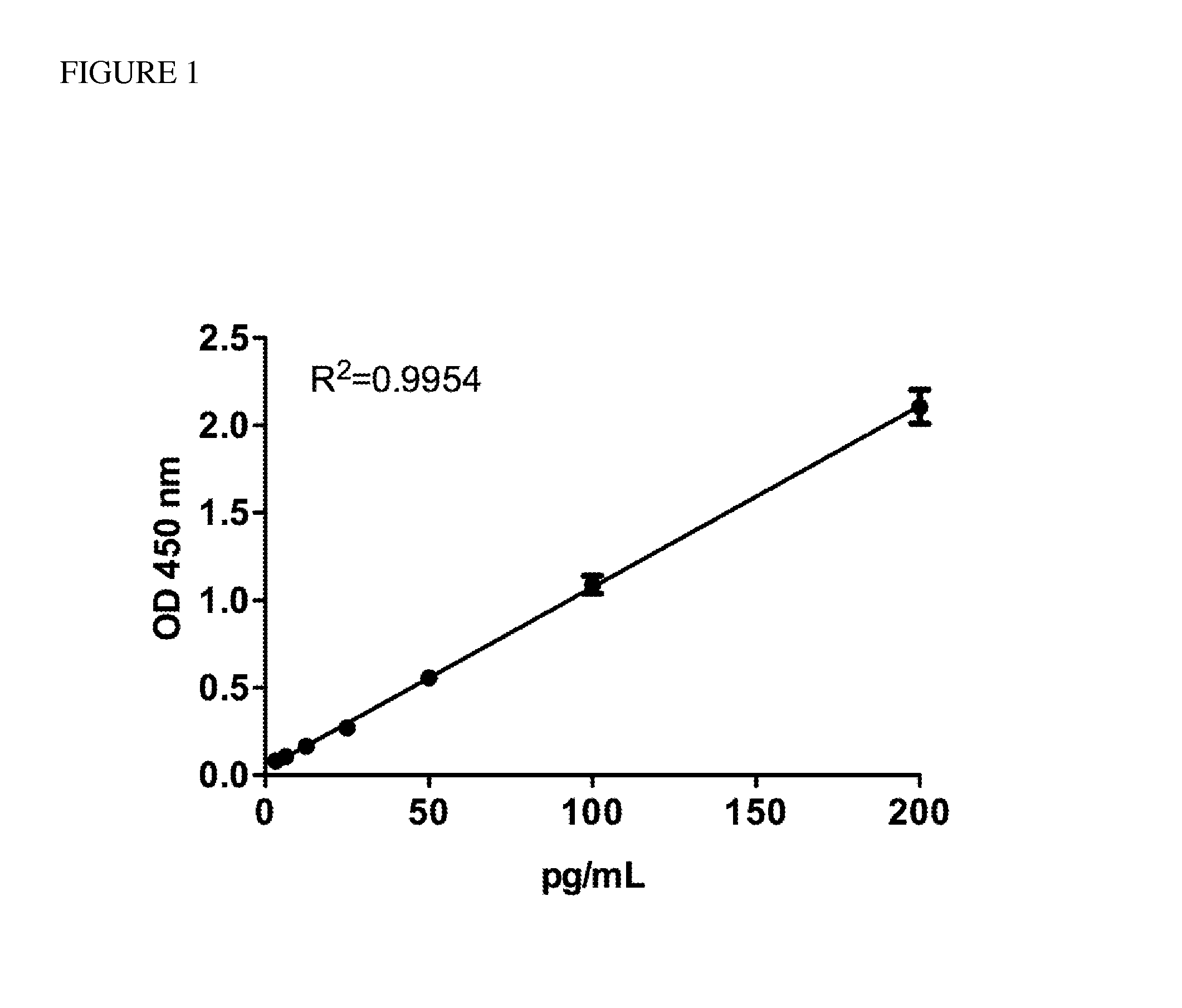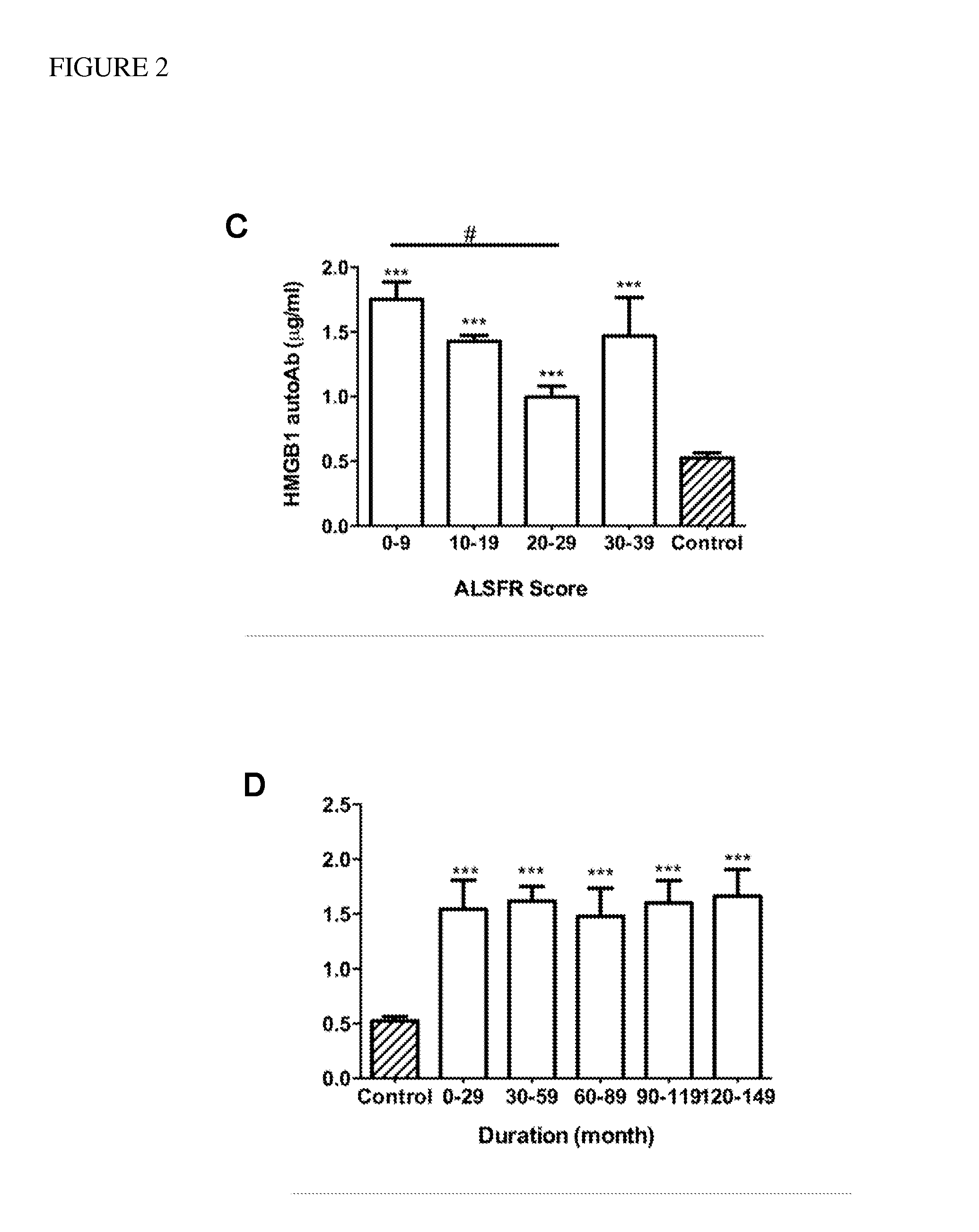Method for Determining and Treating Amyotrophic Lateral Sclerosis
a technology of amyotrophic lateral sclerosis and amyotrophic lateral sclerosis, which is applied in the direction of biocide, drug composition, instruments, etc., can solve the problems of total paralysis, oxidative stress and death of motor neurons, and none of these markers is effective in clinical practi
- Summary
- Abstract
- Description
- Claims
- Application Information
AI Technical Summary
Benefits of technology
Problems solved by technology
Method used
Image
Examples
example 1
Characteristics Participants and Isolation of Serum
[0062]Thirty-six patients with SALS (20 males, 16 females), four patients with FALS (3 males, 1 female), and 40 age-matched controls (23 males, 17 females) were recruited for study enrollment at the Motor Neuron Disease Center of Taipei City Hospital in Taiwan. All participants were Taiwanese and were free of infectious disease at the time of study initiation. None of the patients with ALS has mutations in SOD1. Ten milliliters of venous blood were collected from all participants, and serum was harvested using yellow-stopper vacationer tube and frozen at −30° C. for use at a later date.
[0063]Demographic information and clinical characteristics of the sample group are shown in Table 1. The age of the patients ranged from 32 to 86 years (mean=61, SEM=13), and that of the controls ranged from 30 to 87 years (mean=60, SEM=17). The clinical severity of ALS was evaluated using an ALS functional rating scale (ALSFRS-R). The ALSFRS-R scores...
example 2
Quantification of Autoantibodies Against HMGB1 Using Enzyme-Linked Immunosorbent Assay (ELISA)
[0064]A home-made ELISA was developed to detect human HMGB1 autoantibody for commercial ELISA kit was unavailable. A rabbit polyclonal antibody against HMGB1 was generated by LTK BioLaboratories (TaoYuan, Taiwan) and purified using a Montage® Ab purification kit (Millipore, Billerica, Mass.). One hundred nanograms of recombinant HMGB1 which needs to be incubated at 4° C. for two weeks were coated onto each well of a 96-well microtiter plate. After incubating at 4° C. for 16 h, the coating solution was removed, and the wells were blocked by incubating with 3% BSA in PBST at 37° C. for 1 h. One hundred microliters of rabbit anti-HMGB1 Ab standards ranging from 3.125 pg / ml to 200 pg / ml and 100 μl of a 5000-fold dilution of serum from patients with ALS were added to the wells, and the plates were incubated at 37° C. for 24 h. Plates were then washed five times with 400 μl PBST. After the final ...
example 3
[0071]Concentrations of each autoantibody were compared between patients with ALS and controls using a two-tailed, Student's t-test. The correlation between revised ALS functional rating scale (ALSFRS-R) and concentrations of HMGB1 autoantibody was plotted using linear regression function of GraphPad Prism 5 software (GraphPad Software, Inc. La Jolla, Calif.). The detection accuracy was measured by analysis of receiver operation characteristic (ROC) curve, which were constructed by plotting the false positive proportion (x=1−specificity) against the true positive proportion (y=sensitivity) for all values of the threshold. Thus, a ROC curve displays the trade-off between the sensitivity and the specificity for all possible thresholds. The performance of the methods was measured as the area under the curve.
[0072]One skilled in the art readily appreciates that the present invention is well adapted to carry out the objects and obtain the ends and advantages mentioned...
PUM
| Property | Measurement | Unit |
|---|---|---|
| concentration | aaaaa | aaaaa |
| cut-off concentration | aaaaa | aaaaa |
| concentration | aaaaa | aaaaa |
Abstract
Description
Claims
Application Information
 Login to View More
Login to View More - R&D
- Intellectual Property
- Life Sciences
- Materials
- Tech Scout
- Unparalleled Data Quality
- Higher Quality Content
- 60% Fewer Hallucinations
Browse by: Latest US Patents, China's latest patents, Technical Efficacy Thesaurus, Application Domain, Technology Topic, Popular Technical Reports.
© 2025 PatSnap. All rights reserved.Legal|Privacy policy|Modern Slavery Act Transparency Statement|Sitemap|About US| Contact US: help@patsnap.com



